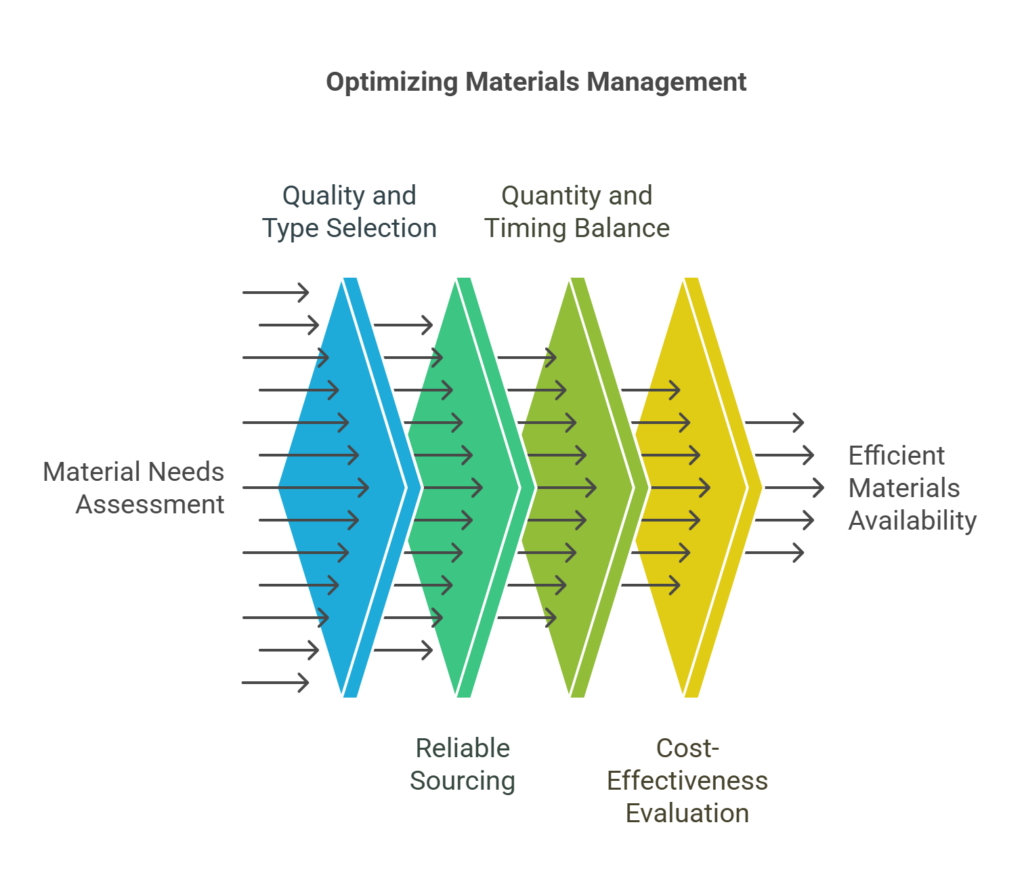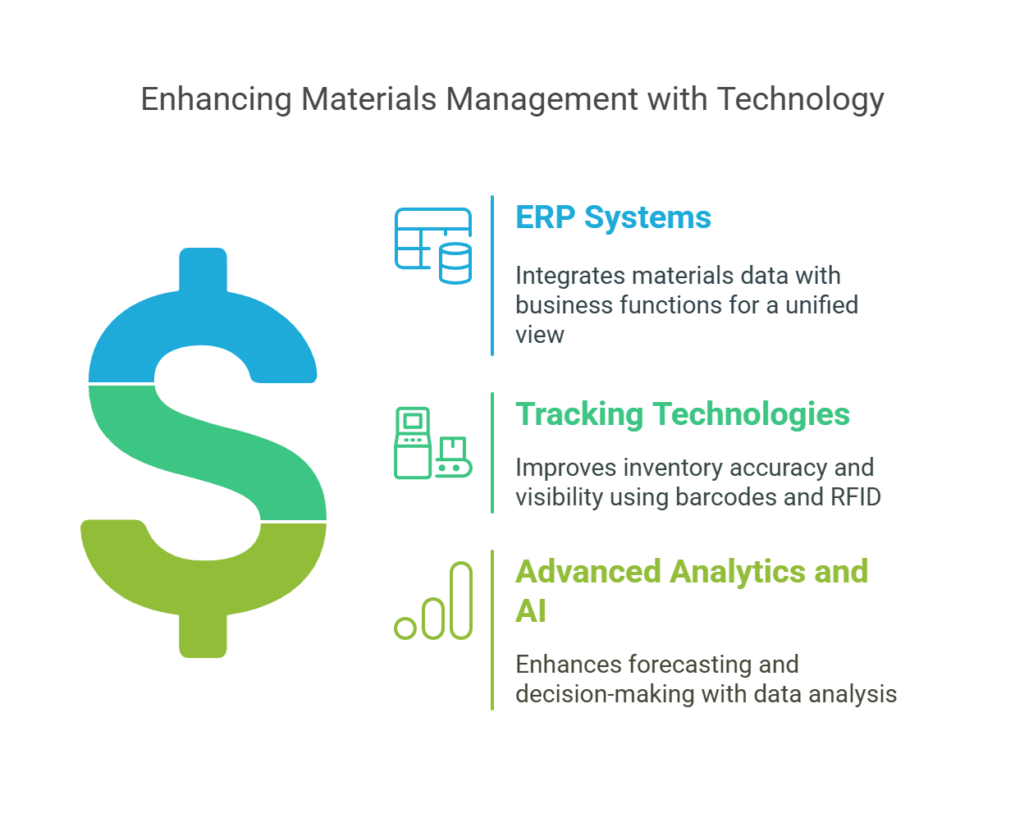Did you know materials management can represent up to 60% of a company’s total expenditures? That’s a huge slice of the pie, as highlighted by the National Association of Purchasing Management. This number really points out how vital strong materials management is for staying competitive and healthy as a business. Are you certain your organization is getting the most out of its materials management strategy for peak efficiency and profit? 🤔
This piece looks into the core parts of materials management, covering everything from keeping track of inventory to adopting greener practices. You’ll find out how to fine-tune your supply chain, cut down on waste, and give your bottom line a healthy boost. Whether you’re deeply experienced in this area or just getting started, you’ll pick up useful ideas to reshape your approach to handling materials. Let’s explore materials management and find strategies that could truly reshape your business operations.
Defining Materials Management
So, what exactly *is* materials management? At its heart, it’s the systematic control over the flow of physical items a company needs. This isn’t just about storing stuff; it covers the entire journey from figuring out what you need, buying it, storing it safely and efficiently, and getting it where it needs to go, whether that’s a production line or a distribution center. It’s a critical function, especially in manufacturing and sectors heavily reliant on physical goods.
The scope is broad, touching purchasing, inventory levels, warehousing logistics, and final distribution. Think of it as the connective tissue holding key parts of the supply chain together, ensuring raw materials, components, and finished goods move smoothly. Effective management here prevents bottlenecks, reduces holding costs, and keeps operations running like a well-oiled machine.
“Materials management is the process of planning, organizing and controlling the flow of materials from their initial purchase through internal operations to the service point through distribution.”-Inbound Logistics
Key Objectives of Materials Management
The primary goal is beautifully simple yet complex in execution: have the correct materials available when needed. This sounds easy, but it involves several interlocking objectives. You need the *right* quality and type of material, sourced reliably. Getting this wrong can halt production or lead to subpar products.
Beyond just having the materials, it’s about quantity and timing. Too much inventory ties up capital and space; too little leads to stockouts and missed sales opportunities. Materials management strives to strike that perfect balance. It also aims to procure these items from the *right* source – reliable suppliers offering good value – and at the *right* price, ensuring cost-effectiveness without sacrificing quality. 💰

Achieving these “five rights” (right material, quantity, time, source, price) directly supports wider business goals. It minimizes operational disruptions, controls expenditures, improves resource use, and ultimately contributes to greater customer satisfaction through reliable product availability. It’s about efficiency and smart spending woven together.
“Materials management aims to balance the conflicting goals of ensuring material availability, minimizing inventory costs, and maximizing customer satisfaction.”-Deskera
Components of Effective Materials Management
A solid materials management system is built on several key pillars working in concert. First up is procurement or purchasing – the process of acquiring the necessary materials. This involves supplier selection, negotiation, placing orders, and managing supplier relationships to ensure a steady inflow of quality goods.
Next comes inventory control and management. This is about knowing what you have, where it is, and how much you need. It involves tracking stock levels, forecasting demand, setting reorder points, and conducting regular stocktakes to maintain accuracy and prevent both shortages and overstocking.
Warehousing and stores management are also vital. This covers the physical storage, handling, and movement of materials within a company’s facilities. Proper warehousing ensures materials are kept safely, are easily accessible, and space is used efficiently. Finally, distribution logistics handle the movement of materials outwards, whether to different internal departments, production lines, or final customers, completing the cycle.
Inventory Management Strategies
Managing inventory effectively is a cornerstone of materials management, and several techniques can help. One popular approach is Just-in-Time (JIT). The idea here is to receive materials only as they are needed for production or sale, drastically reducing inventory holding costs and waste. JIT requires incredibly precise coordination with suppliers and a stable demand forecast.
Another common method is calculating the Economic Order Quantity (EOQ). This formula helps determine the optimal order size to minimize the combined costs of ordering and holding inventory. It balances the cost of placing frequent small orders against the cost of holding larger amounts of stock. While useful, EOQ assumes steady demand and costs, which isn’t always realistic.
ABC analysis is a way to categorize inventory based on value. ‘A’ items are high-value, making up a small portion of total items but a large portion of total value. ‘B’ items are moderate, and ‘C’ items are low-value but numerous. This helps prioritize control efforts, focusing tighter management on the crucial ‘A’ items. Choosing the right mix of strategies depends greatly on the specific items, demand patterns, and business context.
“Effective inventory management is crucial for businesses to ensure they have enough stock on hand to meet operational demand without holding excess inventory.”-ABL Group
Technology in Materials Management
Technology plays a massive part in modern materials management, offering tools to improve nearly every aspect. Enterprise Resource Planning (ERP) systems often form the backbone, integrating materials data with other business functions like finance, sales, and production. This provides a unified view and helps streamline planning and execution. 💻
Tracking technologies like barcodes and Radio Frequency Identification (RFID) have revolutionized inventory accuracy and visibility. RFID tags, for instance, allow for real-time tracking of materials as they move through the supply chain without needing line-of-sight scanning. This reduces manual errors and provides up-to-the-minute location data.
Furthermore, advanced analytics and Artificial Intelligence (AI) are changing the game in forecasting and decision-making. AI-powered tools can analyze vast amounts of data to predict demand more accurately, identify potential disruptions, and even suggest optimal inventory levels or sourcing strategies. These technologies empower managers with better insights for smarter choices.

Sustainable Materials Management
Sustainability is no longer a niche concern; it’s becoming central to responsible materials management. The focus is shifting towards minimizing environmental impact throughout a material’s entire life cycle, from extraction and production to use and disposal. This involves thinking differently about resource consumption and waste generation. ♻️
Key ideas include promoting a circular economy, where materials are reused, repaired, or recycled instead of being discarded after a single use. This approach aims to keep resources in circulation for as long as possible. Other practices involve actively seeking out environmentally friendly or recycled materials, reducing packaging waste, and optimizing transportation routes to lower carbon emissions.
“Sustainable materials management is ‘a systematic approach to using and reusing materials more productively over their entire life cycles.’”-Inbound Logistics (quoting EPA)
Challenges in Materials Management
Despite the best planning, materials management faces hurdles. Demand volatility is a big one; sudden spikes or drops in customer orders can wreak havoc on inventory levels and production schedules. Predicting shifts accurately remains a constant challenge, especially in fast-moving markets.
Supply chain disruptions are another major headache. Events like natural disasters, geopolitical instability, supplier bankruptcies, or transportation delays can interrupt the flow of materials unexpectedly. Building resilience and having contingency plans are essential to mitigate these risks. Cost fluctuations for raw materials, energy, and transport also require constant monitoring and agile responses.
Best Practices for Optimizing Materials Management
Want to sharpen your materials management game? Start with strong supplier relationships. Collaborating closely with key suppliers fosters trust, can lead to better terms, improves reliability, and provides early warnings of potential issues. Treat suppliers as partners, not just vendors. 👍
Embrace data-driven decision making. Use the information from your ERP systems, tracking tools, and forecasts to guide your choices about inventory levels, order quantities, and supplier selection. Regularly analyze performance metrics (KPIs) to identify areas for improvement and track progress over time.
Adopt a mindset of continuous improvement. Regularly review your processes, seek feedback from your team, and explore new technologies or strategies. Methods like Lean or Six Sigma can help identify and eliminate waste and inefficiencies within your materials flow. Don’t rest on your laurels; always look for ways to do things better.
“Implement stringent quality control procedures as best practice, these issues and potential losses can be minimised by identifying and monitoring the quality of materials consistently, and preventing problems further down the line.”-ABL Group
The Role of Materials Management in Supply Chain Optimization
Materials management isn’t an isolated function; it’s deeply intertwined with the entire supply chain. Its effectiveness directly impacts upstream activities like sourcing and supplier management, as well as downstream activities like production scheduling and customer order fulfillment. Smooth material flow is fundamental to overall supply chain performance.
When materials management is optimized, it leads to reduced lead times, lower inventory holding costs across the chain, improved production efficiency, and faster response times to customer demand. This synergy enhances the competitiveness of the entire supply chain, contributing positively to customer satisfaction and the company’s financial health.
Future Trends in Materials Management
The field of materials management continues to evolve. Automation is set to play an even bigger role, from automated storage and retrieval systems (AS/RS) in warehouses to robotic process automation (RPA) for handling routine procurement tasks. This promises greater speed, accuracy, and efficiency. 🚀
Blockchain technology holds potential for unprecedented transparency and traceability in supply chains. It could provide an immutable record of a material’s journey, verifying authenticity and tracking provenance, which is particularly valuable for high-value goods or regulated industries. Advanced analytics and predictive modeling will also become more sophisticated, allowing for more proactive management of inventory and potential disruptions.

Case Studies: Successful Materials Management in Action
Many companies showcase excellent materials management. Consider Toyota, famous for pioneering the Just-in-Time (JIT) system. By minimizing inventory and coordinating closely with suppliers, Toyota dramatically cut waste and costs, setting a benchmark for lean manufacturing. Their success hinged on supplier partnerships and relentless process refinement.
Zara, the fast-fashion retailer, provides another compelling example. Their agile supply chain relies on quick turnaround times, achieved partly through efficient materials management. They keep a significant portion of production in-house or nearby, use RFID for meticulous inventory tracking, and leverage real-time sales data to quickly adjust material orders and production, responding rapidly to fashion trends.
Amazon’s vast fulfillment network is a testament to sophisticated materials (in this case, finished goods) management on a massive scale. They use advanced robotics in warehouses, predictive analytics for demand forecasting and inventory placement, and a complex logistics network to ensure fast delivery. These examples show how tailored strategies, technology, and continuous optimization drive success.
FAQ: Common Questions About Materials Management
What is the difference between materials management and inventory management?
Inventory management focuses specifically on overseeing the quantities and storage of goods (raw materials, work-in-progress, finished products) within a company. Materials management is broader; it includes inventory management but also covers procurement (sourcing and purchasing), planning, receiving, warehousing, and the movement of materials throughout the supply chain.
How can materials management reduce costs in a business?
Effective materials management cuts costs in several ways: minimizing inventory holding expenses (storage, insurance, obsolescence), securing better prices through smart procurement and negotiation, reducing waste from spoilage or damage, lowering transportation costs through optimized logistics, and preventing costly production stoppages caused by material shortages.
What skills are essential for a career in materials management?
Key skills include analytical abilities (for forecasting and data analysis), negotiation skills (for procurement), problem-solving capabilities (for handling disruptions), strong organizational skills, attention to detail, proficiency with relevant software (like ERP systems), and good communication skills for coordinating with suppliers, internal teams, and logistics providers.
How does materials management impact customer satisfaction?
It has a direct impact. Good materials management ensures products are available when customers want them (preventing stockouts), helps maintain product quality by managing materials properly, and contributes to faster order fulfillment and delivery times. Reliable availability and timely delivery are huge factors in keeping customers happy.
What are the key performance indicators (KPIs) for materials management?
Common KPIs include inventory turnover rate, stockout frequency/rate, carrying cost of inventory, purchase price variance, on-time delivery rate from suppliers, warehousing costs per unit, forecast accuracy, and rate of inventory obsolescence or spoilage. Tracking these helps measure efficiency and identify areas needing attention.
Conclusion
Getting materials management right is clearly essential for any business dealing with physical goods. It impacts everything from day-to-day operational smoothness to the bottom line. By focusing on the core objectives, utilizing smart strategies and technologies, and embracing best practices like supplier collaboration and continuous improvement, companies can build a resilient and efficient flow of materials.
In today’s fast-paced business environment, where supply chain agility is key, mastering materials management offers a distinct competitive advantage. Applying the insights and strategies discussed can lead to considerable gains in efficiency, cost savings, and overall business strength. For companies aiming to truly modernize and streamline their approach, exploring specialized support can make all the difference. Nektar.io provides advanced services designed to optimize your materials management processes. Check out https://nektar.io to see how their expertise could help your business achieve new levels of performance.
Key Takeaways:
- Effective materials management can significantly reduce costs and improve operational efficiency
- Integrating technology and sustainable practices is crucial for modern materials management
- Overcoming challenges in materials management requires a strategic, data-driven approach
- Continuous improvement and adaptability are key to successful materials management in a changing business scene



